Even though KubeCon has been running since 2015—first sponsored by KubeAcademy and later taken over by Linux Foundation’s Cloud-Native Computing Foundation (CNCF)—this was my very first time there, as it was for 60% of the 7,000 onsite participants (more joined in virtually).
There’s no doubt that Kubernetes has become a major force since it was first launched in 2014. According to a Cloud Native Computing Foundation report from IOD partner SlashData, use of Kubernetes shot up in 2021 by 67% over the previous year. As many as 31% of backend developers—some 5.6 million people—now rely on Kubernetes at the heart of their development environment.
But even given those impressive statistics, the biggest question on my mind as I headed to Valencia was: Is there enough going on in the Kubernetes world to justify an entire conference?
The answer to that question, I’m happy to report, is a resounding yes.
An Entire Conference About K8s?
As an individual independent cloud analyst for leading vendors such as AWS and Google Cloud, I am considered media, which gives me access to hang out with show floor vendors including both newer and more familiar companies like Sysdig, Solo.io, and CloudCasa.
Rubbing shoulders with David Safaii, CEO of Trilio, a cloud-native data protection platform, I asked what he’s seeing in terms of where his customers commonly deploy their Kubernetes clusters. His answer was clear and decisive: In first place, he noted, is EKS from AWS; next is Azure’s AKS; and Trilio’s remaining customers—comprising mainly SMBs and telcos—are using OpenShift and other solutions.
I heard similar reports from a number of vendors, and Statista backs up these anecdotal impressions: The latest data from 2021 indicate that 49.8% of Kubernetes clusters are running on AWS, 34.5% in Azure, and a further 24.6% on Google Cloud.
But my biggest takeaway from this conference was something I found myself hearing over and over:
“Kubernetes has become the open-source operating system of cloud.”
For a long time now, the Holy Grail of cloud development has been abstracting infrastructure— compute, network, and storage—to the point where it is obsolete to the end user.
Many platforms have attempted to provide this over the years, billing themselves as “multicloud enablers,” but they still require the user to be involved. For example, you are asked to “choose your cloud” or the infrastructure to some extent. Only Kubernetes has brought us close—and we’re getting closer every year—to creating a true cross-cloud, cloud-agnostic infrastructure in which any code can run anywhere: on-premises, and on the public cloud, including AWS, Azure, or Google.
That’s where the greatest opportunity lies: cross-cloud, not multi-cloud. And when we look at how Kubernetes has become the de facto standard for that purpose, I hope it’s clear why KubeCon is so important.
Of course, that doesn’t mean we’re all the way there yet.
An Immature Fragmented Market
Strolling from one vendor booth to the next, it was clear that the market is still highly fragmented, with multiple small early-stage vendors. These each address a particular niche management challenge, for example, protection and backup, authentication, security, cost control, and more.
Many of these Kubernetes solution vendors have a solid offering; however, DevOps teams, in both enterprise settings and growing startups, still have to piece these solutions together from multiple vendors since there’s no one vendor offering a full suite of best-in-breed solutions. As the market matures, these are going to need greater integration and simplified management supported by a single platform.
To fill this gap, and create a solid mega-platform offering, larger companies like Palo Alto Networks are running an aggressive acquisition strategy that will help them demonstrate a broad range of capabilities, as you can see in the slide below.
This is the same phenomenon we saw in the public cloud space as a whole starting around 2012-2013. But now that the cloud market has settled down, the Wild West mood has shifted into the Kubernetes space.
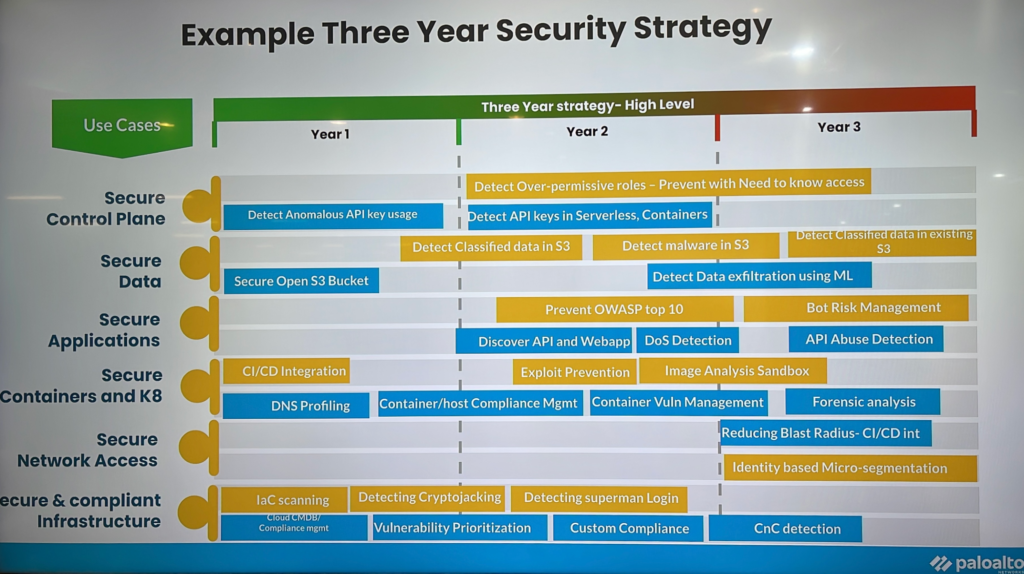
Figure 1. Slide from Palo Alto Networks’ offering presentation at their booth at KubeCon
In the image above, you can see Palo Alto Networks’ planned expansion of offerings to create a comprehensive platform over time. For example, in 2019, Palo Alto acquired Twistlock, a solution providing vulnerability management, compliance, and runtime defense for cloud-native applications and workloads. Now called Prisma™ Cloud Compute Edition, this component provides vulnerability management and compliance for containers and Kubernetes, the bottom use case in the slide shown.
Check out some of our moments:

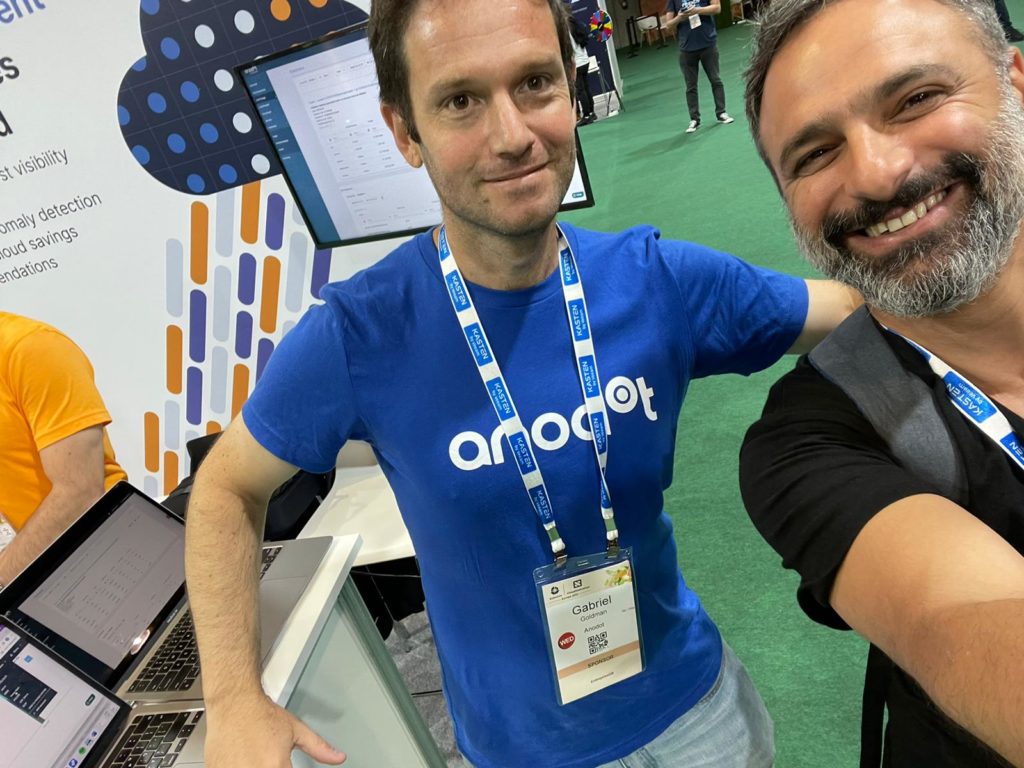
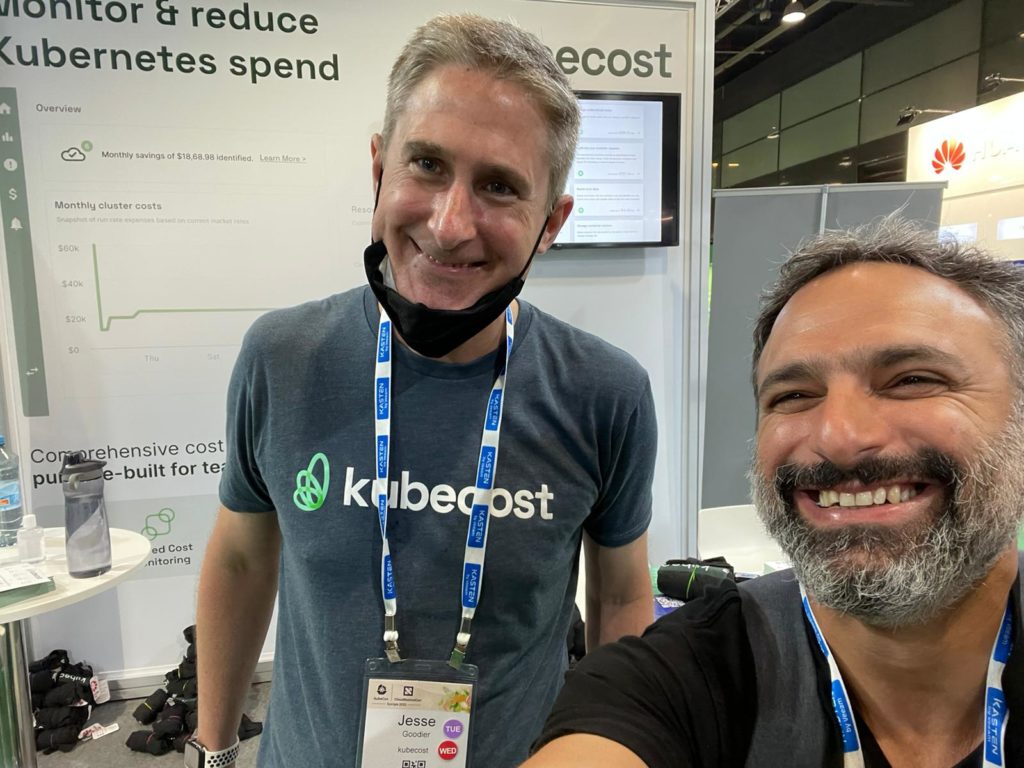



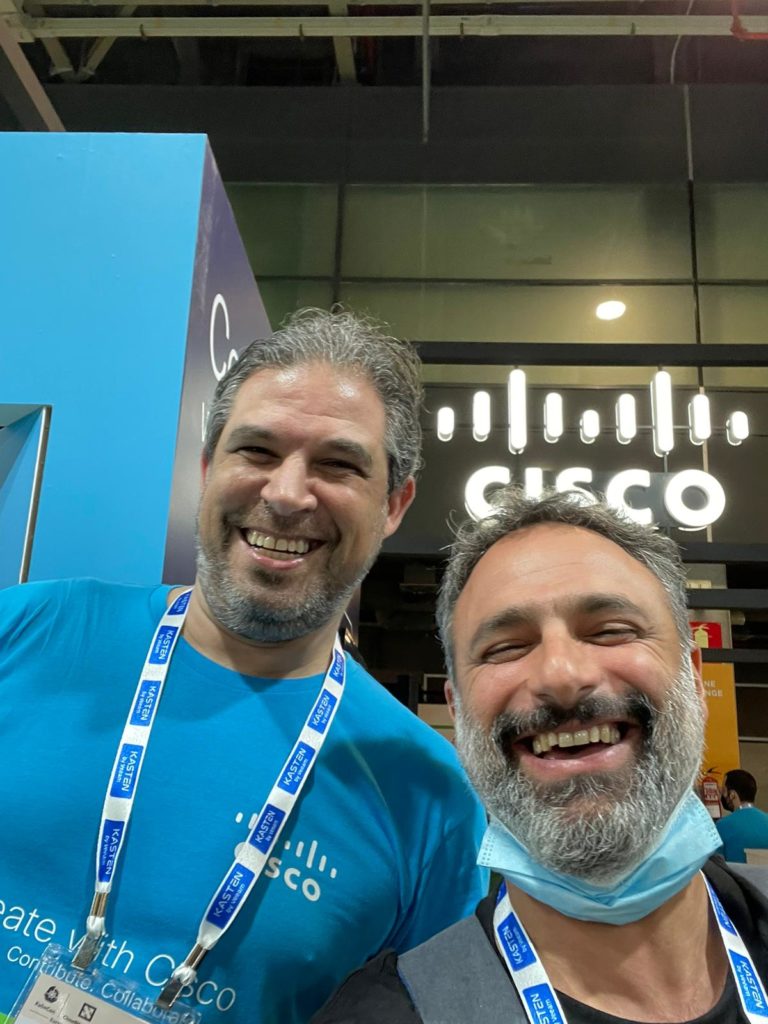
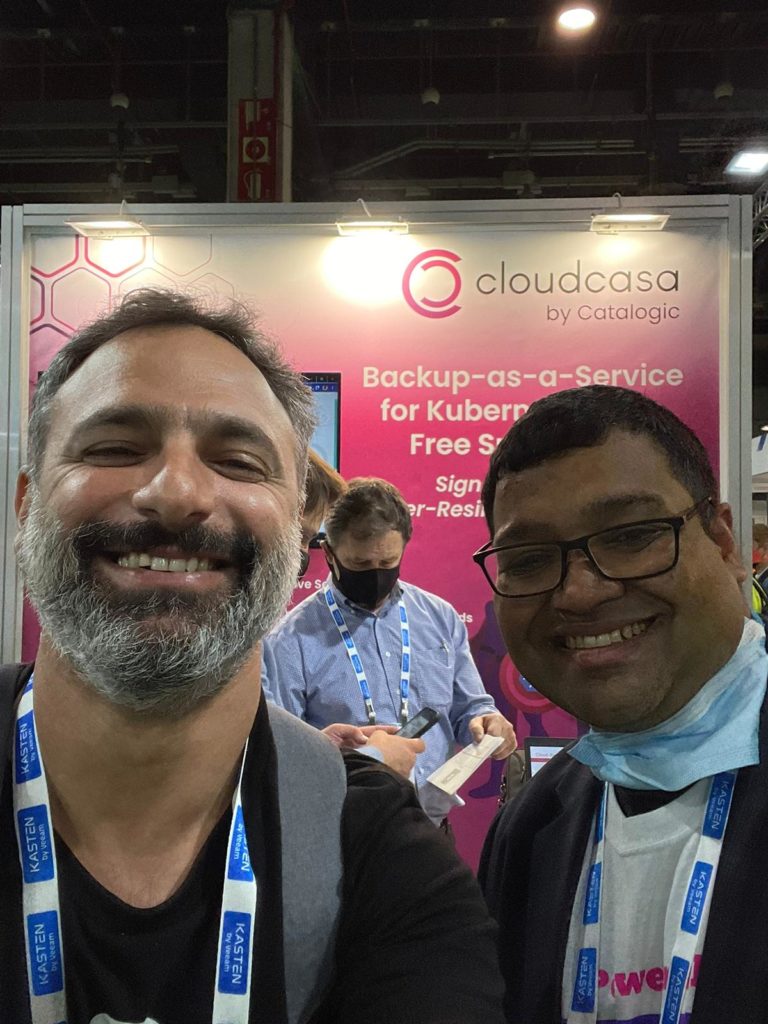


The Practitioner or the Tech Brand Target Audience
Another reason this conference is so important is the huge difference in its attendees from other conferences I’ve been to. At most conferences, I see and talk to a wide mix of C-suite and mid-level people, and not so many actual practitioners. At KubeCon, that mix was upside-down, with a massive audience of practitioners consisting of younger developers and DevOps geeks gathering to learn, find solutions, and drink a beer together.
For the most part, the messaging and sessions were right on target for that audience, like a GitOps session I attended the first day. Disappointingly, though, some vendors didn’t seem to have a clear understanding of the unique audience who had come to learn specific technical practices. They were trying to attract attention with fluff messages about high-level concepts like the “cloud skills gap” and “what is DevOps?”
Sometimes, when I speak to potential IOD customers and ask them about who they see as their target audience, it sounds like they’re trying to have it both ways: They want to appeal to both the practitioner audience and the C-level decision-makers. This always results in a lack of focus. As I’ll explain in a second, bottom-up adoption is happening in more and more enterprises, and to drive this movement, you need powerful, expert-based content that appeals to practitioners.
Two Major Go-to-Market Methods in the K8s World
Beyond greater movement towards a true cross-cloud future—facilitated by Kubernetes—I came home more aware than ever of two strong models that are going to prove even more influential over the next year or two.
# 1 Bottom-Up Adoption of Services
When I stopped to chat on the show floor with Jonathan Kaftzan, CMO of ARMO, a Kubernetes security platform, he told me, “If your young technology is still not a product, they (the DevOps experts) will quickly notice that and will kill the opportunity of using your service.”
*(Full disclosure: ARMO has worked with IOD to create strategic, expert-based tech content to appeal to the practitioner level. You can read all about it in this case study.)
I’ve been covering the world of cloud for more than a decade now, and that’s involved watching bottom-up adoption (BUA) become one of the most important strategic go-to-market approaches for technology vendors.
Why?
Well, previously, the CIO or CTO might ask their tech team to check out a solution vendor’s application. The tech teams would test the product and report back. But in many cases, that C-level person’s mind had already been made up, based on the sales pitch, price point, or a range of other factors.
BUA relies on the idea that you just can’t fool the expert, no matter how much marketing fluff you throw at the people who hold the purse strings.
Today, practitioners have become researchers spending their time on Google and social media hunting down a solution in the form of a small piece of code, an open-source package, or a commercial solution. Once they get hold of a solution, without necessarily running it past the C-level people, they’ll try it out as a freebie, see how well it works, and then drive the sale from the bottom. Hence the term bottom-up adoption.
One of the exciting things about BUA is that a typical buying decision can take place without anybody in the organization making contact with a salesperson. (In fact, development giant Atlassian famously thrived through its first decade without hiring any sales staff.) It’s the product itself—its capacity to help the practitioner on a day-to-day basis—that’s selling these products.
Which actually leads me to the second trend that stood out very clearly in Valencia…
# 2 Product-Led Growth (PLG)
Product-led growth is a natural corollary of BUA, and at KubeCon, I noticed a sharp increase in companies adopting this model. Beyond big names like Canva and Shopify, which have seen tremendous gains even in a shaky SaaS market thanks to PLG, even smaller players are embracing this model more and more.
PLG, as a philosophy, centers around three principles:
- Be product-centric: Sites and applications must sell themselves.
- Offer lifetime value: Focus on expanding relationships rather than just a single sale or subscription.
- Implement shared responsibility: The entire team is responsible for sales growth, not just marketing.
Creating “freemium” offerings and naturally funneling the user from free to paid offerings as they come to trust and rely on the product is the lifeblood of both BUA and PLG.
The need to create products that behave this way is placing new demands on the types of practitioners who flocked to KubeCon. Traditionally, they’ve been siloed off from decisions around product planning and lifetime value. This shift is creating new strategic processes in which multidisciplinary teams are empowered to think out of the box and take a user-first perspective that will mean great things for the industry in the long run.
Would I Go Back?
Well, I won’t keep you in suspense. The answer is definitely.
For the most part, the sessions and keynotes at KubeCon Valencia 2022 were very substantial. If you follow my blogs, you already know I’ve been a big fan of AWS for years and one big reason for this is their ability to guide their tech leaders to run highly practical, educational sessions that steer clear of fluff. That same focus puts KubeCon solidly in the ranks of a major conference like AWS re:Invent.
In fact, having seen what KubeCon has to offer, I’m sorry I missed every previous KubeCon since 2015. For a veteran cloud blogger, this conference is a peek into the future of distributed development.
To find out more about who we met and chatted with at KubeCon, stay tuned. At every conference, we love to “run the floor,” getting to every booth and learning about vendors’ solutions so we can cover them on our blog. So keep an eye out for our blog round-up coming soon: “KubeCon 2022 Show Floor: 9 Solutions You Want to Check Out.”
Tl;dr – Out of all the conferences out there, this one is a don’t-miss. See you next year at KubeCon 2023!

